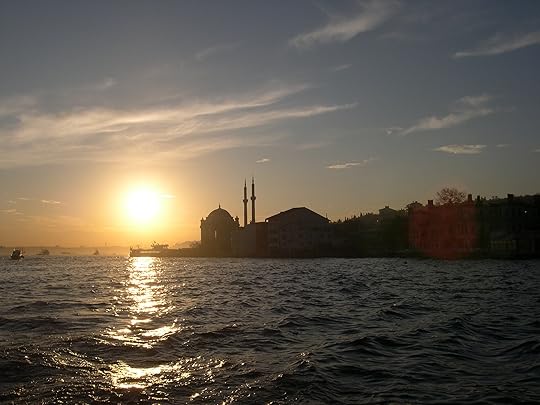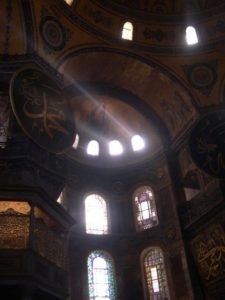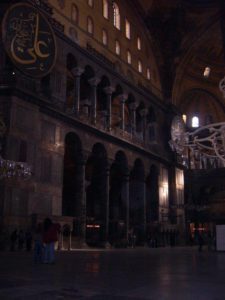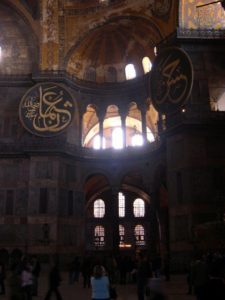The Importance of Istanbul

Why should we all care? Because Istanbul is a pillar of history that assists us in telling the story of humanity since 6000 BC. Because it is colorful and diverse and secular and religious and straddles two continents. And not least, because freedom of religion and freedom of speech are under attack in a country that plays a critical role in stemming the free movement of radical terrorists from the Middle East to Europe and wannabe terrorists into the Middle East.
Massive times of history must be examined to determine which events allowed this ancient city to be the leadership seat of four empires. Yes, four. Istanbul, formerly Constantinople, holds the rare honor of having been a bastion of Christianity for centuries before its conversion to a Muslim capital. Not only has her religion been fought over for hundreds of years, but her 5,343 square meter area is divided by the Bosphorous Strait so that Istanbul resides in both Europe and Asia. If these theoretical and geographic challenges don’t scream “split personality”, I can’t imagine what would. And yet, charismatic Contantinople has capitalized on her unique set of attributes in a way that hasn’t been repeated throughout history.
Constantine the Great, credited with the shift of Roman power eastward, he became the emperor of the entire Roman Empire in 304 AD. It was he who transformed the city into a center of Christianity and Greek culture. For nearly 1500 years, the Romans ruled Constantinople as she grew into the wealthiest and largest city on the European Continent. The impressive Hagia Sophia, literally ‘divine wisdom’ was built in 537 AD and remained the largest cathedral in the world for over a thousand years.
To stand inside her walls is to feel her old soul live and breathe—and to hear the echo of her tears.
In the middle of the 14th century, the Ottoman Turks began a campaign to take over small Roman towns one by one. Over two months, when the last Roman Emperor had been killed, the slow strangulation of Istanbul’s supply routes ultimately weakened her to a state where the Turks could breach the city walls. The Romans (aka “Byzantines”) fled. Some made a fateful decision to take refuge in the holy cathedral, Hagia Sophia, and were slaughtered in it. Afterwards, Sultan Mehmet II called an imam to the building to declare it an Imperial Mosque. The imam proclaimed, “There is no God but Allah” and thus began the Istanbul’s transformation to a Muslim state. 13 minarets were installed on the mosque to call the faithful to prayer.
This too was a period of substantial development for the city. The labyrinthine Grand Bazaar was opened in 1461 and thrives today. Her 5,500 vendors and 65 alleyways are a trove of treasures too numerous to mention. Carefully-handcrafted carpets line the walls next to shining multicolored brass lamps. Fake leather Chanel bags mingle with sparkling belly-dancer costumes. Turkish delight and spices reign supreme. Stall owners still pay their rent–a hefty 7 kilos annually for shops on the main avenue–in gold.
The Turks also built the sultan’s official residence, lavish Topkapi Palace, in 1478. When entering the Imperial Gate, be sure to note the recessed niches included to display the severed heads of criminals and rebels. Topkapi Palace, the strategic command center of the Ottoman Empire, doubled as the pleasure palace with harems numbering into the thousands. No members of the harem were Muslim, however, as it is forbidden for Muslims to enslave Muslims.
World War I brought the end of the Ottoman Empire and the exile of the last sultan, Mehmed VI. The British, Italians, and French occupied the city until the Treaty of Lausanne was signed and brought official recognition to the Republic of Turkey. The long fought over Hagia Sophia was declared a museum, eliminating any argument over which religion would worship there. The decision remains controversial with Muslims calling frequently for the sacred building to be restored as a mosque.
Today, the future of Istanbul–and indeed Turkey–seems uncertain. As the gateway between East and West, her responsibilities are great—and so are the risks. President Recep Tayyip Erdogan is negotiating for his country to become a European Union member while instituting a number of strong-arm decisions that color him with dictatorial shades. This includes a recent call to restore the death penalty to deal with those involved in the coup attempt, something that all EU member states must strongly disavow.
The previously underlying current of distrust for Mr. Erdogan has raised its head above the surface. Protestors regularly share their displeasure with the shift to greater authoritarian rule. Add to this the vicious terrorist attacks which have lately claimed far too many victims and you can see why Turkey is on the brink. Istanbul’s critical position on the world stage must be supported from within and without. No stranger to conflict, any one man who attempts to dominate her will eventually face a fearsome wrath. Perhaps this was not yet the moment, but the moment may yet arrive.
The post The Importance of Istanbul appeared first on Worldwise Publications.






